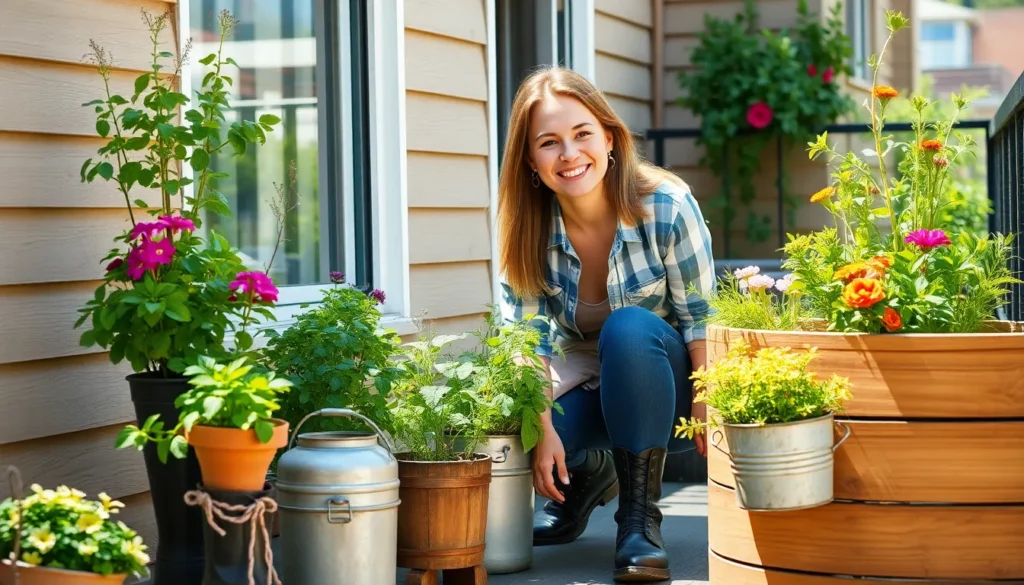We’ve all been there – staring at a bare patio or balcony wondering how to transform it into a lush garden paradise. Container gardening offers the perfect solution whether you’re dealing with limited space poor soil or simply want more control over your growing environment.
Creative container gardening opens up endless possibilities beyond traditional terracotta pots. From repurposed household items to stunning architectural planters we’ll show you how to maximize your growing space while creating visual impact that’ll make your neighbors take notice.
The best part? You don’t need acres of land or perfect soil conditions to grow thriving plants. With the right containers proper drainage and strategic placement you can cultivate everything from herbs and vegetables to flowering displays that rival any traditional garden bed.
Repurposed Household Items for Creative Container Gardens
Household items that’ve outlived their original purpose can become stunning garden containers with a bit of creativity. We’ll explore unique repurposing ideas that’ll transform everyday objects into charming planters while adding personality to your container garden.
Old Boots and Shoes as Whimsical Planters
Wellington boots make excellent containers for small plants and succulents with their waterproof design and built-in drainage capabilities. We recommend drilling 2-3 small holes in the sole to prevent water logging while maintaining the boot’s structural integrity. Canvas sneakers work beautifully for temporary seasonal displays since they naturally allow excess moisture to escape through the fabric.
Leather boots create rustic charm when planted with trailing herbs like thyme or oregano that cascade over the sides. Position these unique planters near walkways or on porch steps where guests can appreciate their playful appeal. Children’s outgrown shoes become perfect mini planters for air plants or small cacti that require minimal soil depth.
Rain boots in bright colors serve as eye-catching focal points when filled with vibrant flowers like pansies or petunias. Group different sized boots together to create an captivating display that tells a story while maximizing your planting space.
Vintage Bathtubs for Large-Scale Gardening
Clawfoot tubs provide exceptional depth and width for growing vegetables that need extensive root systems like tomatoes and peppers. We suggest positioning these substantial containers in sunny locations where their generous size can accommodate multiple plants without overcrowding. Cast iron tubs retain heat effectively, extending growing seasons in cooler climates.
Fiberglass bathtubs offer lighter weight alternatives that’re easier to relocate when needed for seasonal changes. Drill drainage holes every 12 inches along the bottom to ensure proper water flow while preventing root rot. These spacious containers excel for creating herb gardens where we can grow basil, parsley, and cilantro together.
Enamel tubs develop beautiful patina over time that adds vintage character to garden spaces. Fill the bottom third with gravel or broken pottery pieces to improve drainage before adding quality potting soil. Their substantial capacity supports impressive displays of ornamental grasses or flowering shrubs.
Kitchen Colanders for Herb Gardens
Metal colanders feature built-in drainage that makes them ideal for herbs prone to root rot like rosemary and sage. We line these perforated containers with coconut fiber or industry fabric to retain soil while allowing excess water to escape freely. Their elevated design promotes excellent air circulation around plant roots.
Plastic colanders in various colors create cheerful herb stations on kitchen windowsills where fresh ingredients stay within easy reach. These lightweight options work particularly well for apartments or rentals where permanent installations aren’t possible. Group different colored colanders together for visual impact while growing complementary herbs.
Stainless steel colanders develop an attractive weathered finish when used outdoors and pair beautifully with modern garden designs. Their durable construction withstands temperature fluctuations better than other materials while maintaining professional kitchen aesthetics. We recommend these for growing cutting herbs like chives and parsley that we harvest frequently.
Wooden Container Solutions for Natural Garden Appeal
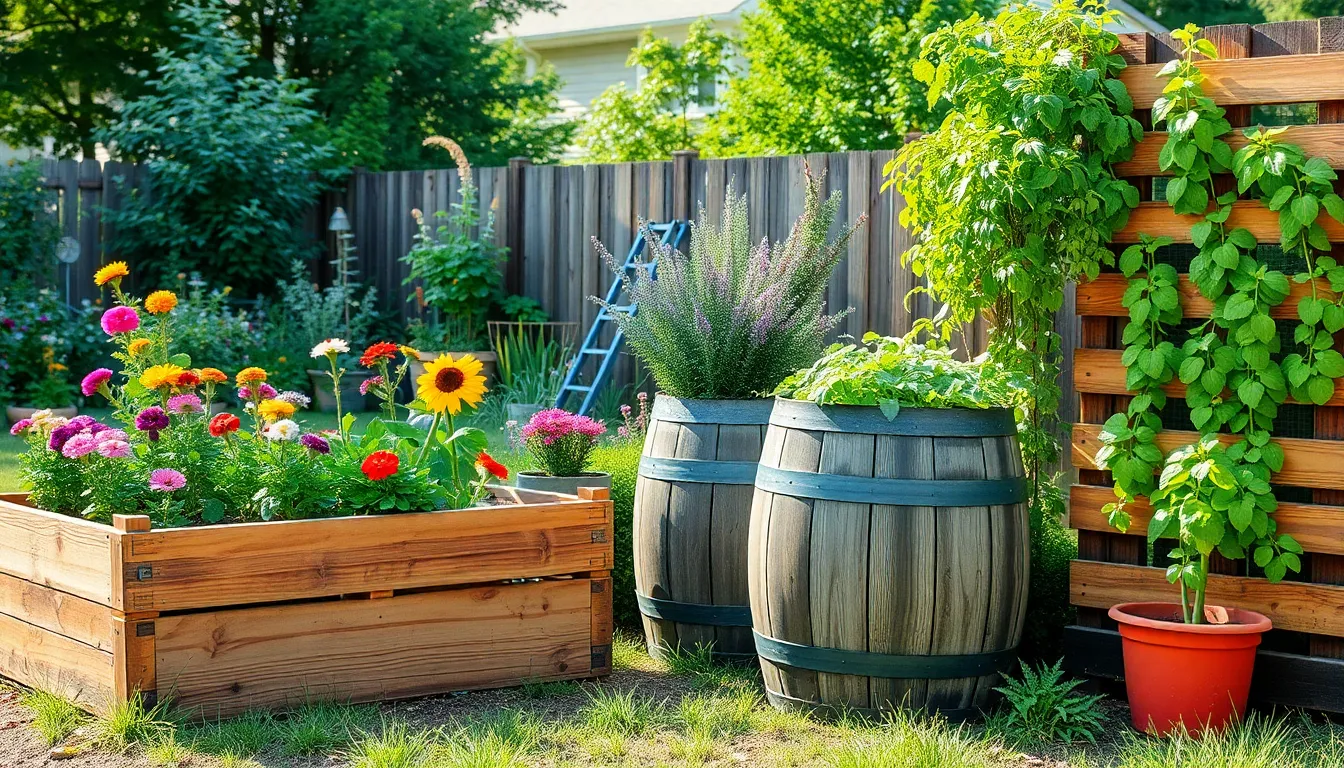
Wooden containers bring warmth and organic beauty to our garden spaces while offering practical benefits that plastic and ceramic options simply can’t match.
Cedar Planter Boxes for Durability
Cedar planter boxes stand out as our top choice for long-lasting garden containers. Natural oils and resins within cedar wood create exceptional resistance to rot and decay, making these planters incredibly durable investments for our outdoor spaces. Weather conditions that would destroy other materials barely affect cedar’s structural integrity over time.
Aesthetic appeal makes cedar planters versatile additions to any garden design. The wood maintains its attractive natural appearance throughout seasons, complementing both modern and traditional landscaping styles. Garden designers consistently choose cedar because it weathers gracefully, developing a beautiful silver-gray patina that enhances rather than detracts from plant displays.
Protection strategies can extend cedar’s already impressive lifespan even further. Applying eco-friendly sealers enhances moisture resistance and provides UV protection, ensuring our cedar containers remain both durable and visually appealing for decades. Regular maintenance with natural wood treatments keeps these planters looking fresh while preserving their structural integrity.
Wine Barrels for Rustic Charm
Wine barrels offer unmatched rustic elegance that transforms ordinary gardens into enchanting spaces. Repurposed oak barrels bring vintage character with their weathered wood and distinctive curved shape, creating focal points that draw attention throughout our garden areas. Each barrel tells a story through its unique aging patterns and wine stains.
Versatility makes wine barrels suitable for diverse planting applications. We can grow everything from aromatic herbs to small fruit trees in these spacious containers, with their deep interior providing ample room for extensive root systems. Large opening diameters accommodate multiple plants, allowing us to create stunning mixed plantings or impressive single-specimen displays.
Sustainability benefits make wine barrel gardens environmentally responsible choices. Repurposing old wine barrels prevents quality materials from entering landfills while giving our gardens authentic character that new containers can’t replicate. Local wineries often sell used barrels at reasonable prices, making this eco-friendly option surprisingly affordable.
Pallet Gardens for Vertical Growing
Pallet gardens maximize our growing space through efficient vertical design. Small garden areas benefit enormously from vertical growing systems, allowing us to cultivate significantly more plants in limited square footage. Walls, fences, and standalone structures become productive growing surfaces when we mount pallet planters strategically.
Cost effectiveness makes pallet gardens accessible to gardeners on any budget. Using reclaimed shipping pallets costs almost nothing while providing sturdy frameworks for multiple planting pockets. Hardware stores and shipping companies often give away pallets, making this the most economical container gardening solution available.
Customization options let us adapt pallet gardens to exact needs and spaces. We can easily modify pallet dimensions, add decorative elements, or combine multiple units to create larger growing walls. Rearranging individual pallets allows seasonal adjustments, helping us optimize sun exposure and accessibility as our gardens evolve.
Metal Containers That Add Industrial Style to Gardens
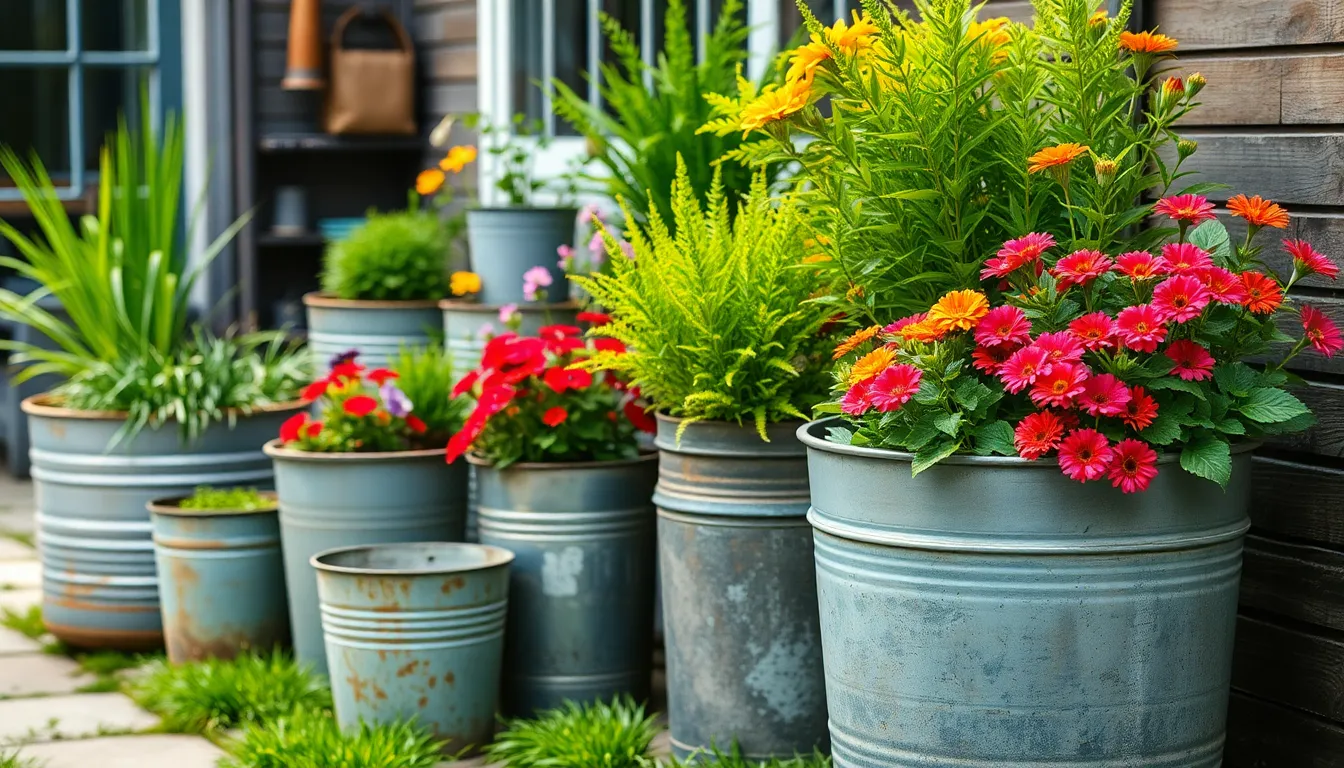
Metal planters bring versatility and modern appeal to any garden space, offering a perfect blend of contemporary design and timeless functionality. These containers showcase materials like corten steel, stainless steel, and powder coated aluminum that can be customized to match different garden themes while remaining lightweight compared to traditional terra cotta pots.
Galvanized Steel Tubs for Modern Aesthetics
Galvanized steel tubs transform ordinary garden spaces with their striking vintage inspired design reminiscent of old washing tubs. We love how these containers create dramatic contrast when paired with lush greenery, instantly elevating the visual appeal of any outdoor area. Their modern aesthetic works beautifully as standalone statement pieces or grouped together for maximum impact.
Positioning these tubs strategically throughout your garden creates focal points that draw the eye and establish visual rhythm. The weathered patina that develops over time adds character while maintaining the clean lines that define modern garden design. You’ll find these containers particularly effective when filled with architectural plants like ornamental grasses or structured perennials.
Vintage Metal Buckets for Small Spaces
Vintage metal buckets offer charming answers for compact gardening areas where every square inch counts. We recommend these containers for porches, balconies, or creative ladder displays that maximize vertical growing space. Their rustic appeal brings warmth to industrial settings while maintaining the edgy aesthetic that metal containers provide.
Adding drainage holes transforms these repurposed treasures into functional planters perfect for seasonal flowers or compact vegetable varieties. Stencil designs enhance their visual appeal, while weathered finishes create authentic vintage character. Grouping buckets of varying sizes creates ever-changing arrangements that work especially well in small urban gardens or apartment balconies.
Repurposed Tin Cans for Herb Collections
Repurposed tin cans create eco friendly answers for growing small herb collections both indoors and outdoors. We find these containers particularly effective for culinary herbs like basil, thyme, and oregano that thrive in compact spaces. Their whimsical appearance adds playful touches to serious garden designs while keeping costs minimal.
Cleaning cans thoroughly and adding proper drainage holes ensures healthy plant growth in these compact containers. Removing labels and applying weather resistant finishes extends their lifespan in outdoor conditions. You can arrange multiple cans on shelving units, windowsills, or hanging systems to create productive herb gardens that fit any space constraint.
Ceramic and Terra Cotta Options for Classic Garden Design
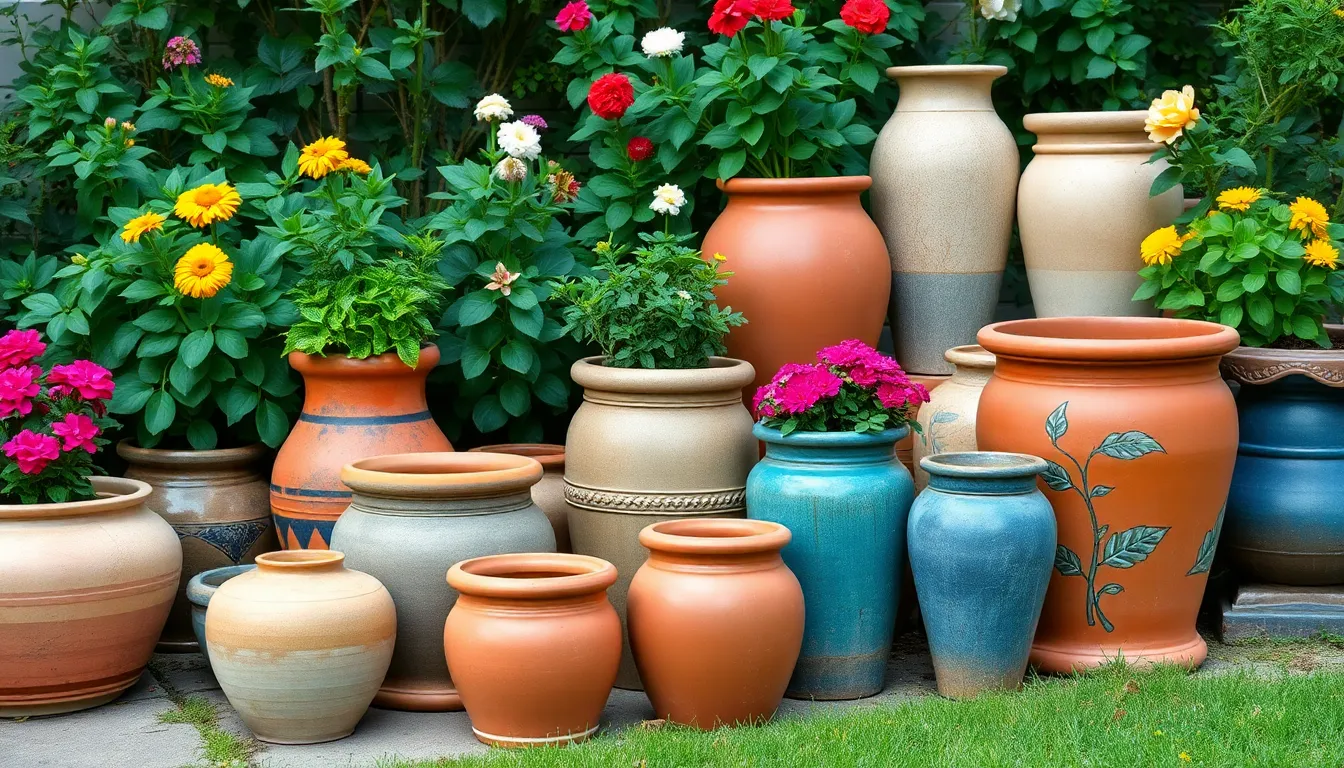
We’re moving into timeless territory with ceramic and terra cotta containers that bring natural warmth and enduring style to any garden space.
Traditional Clay Pots in Various Sizes
Traditional terra cotta pots offer the perfect blend of functionality and natural beauty for our container gardens. These porous clay containers promote healthy root growth by allowing air circulation and moisture regulation that plants absolutely love. Available in sizes ranging from small seedling containers to large statement planters, they accommodate everything from delicate annuals to robust perennials and small shrubs.
Their earthy tones enhance both rustic cottage gardens and refined contemporary spaces with equal grace. We can create stunning displays by grouping different sized pots together, using the largest ones as anchor pieces and smaller containers for accent plants. The natural aging process of terra cotta adds character over time, developing a beautiful patina that speaks to the authentic gardening experience.
Glazed Ceramic Containers for Color Coordination
Glazed ceramic pots unlock a industry of color possibilities that terra cotta simply can’t match. These containers provide the perfect canvas for color matching or creating bold accent pieces that complement our garden themes. Their glossy finish reflects light beautifully, making both the container and plants more visually striking in any setting.
Available in many shapes, sizes, and finishes, glazed ceramics work seamlessly for both indoor and outdoor applications. We can choose coordinated colors to create cohesive displays or select contrasting hues that make our plantings pop against the backdrop. The non porous surface retains moisture longer than traditional clay, making them excellent choices for plants that prefer consistent soil moisture.
Mexican Talavera Pots for Southwestern Flair
Mexican Talavera pottery brings distinctive hand painted patterns and vibrant colors that transform ordinary container gardens into artistic statements. These unique containers feature traditional Mexican craftsmanship with glazed surfaces that resist weather damage while maintaining their brilliant colors season after season.
Talavera pots work exceptionally well as focal points in outdoor patios and Mediterranean themed gardens. Their bold patterns and rich blues, yellows, and greens create stunning contrasts with green foliage and colorful blooms. We can use larger Talavera planters to anchor key garden areas or group smaller pieces together for dramatic impact that celebrates this authentic artistic tradition.
Unconventional Materials for Unique Garden Container Ideas
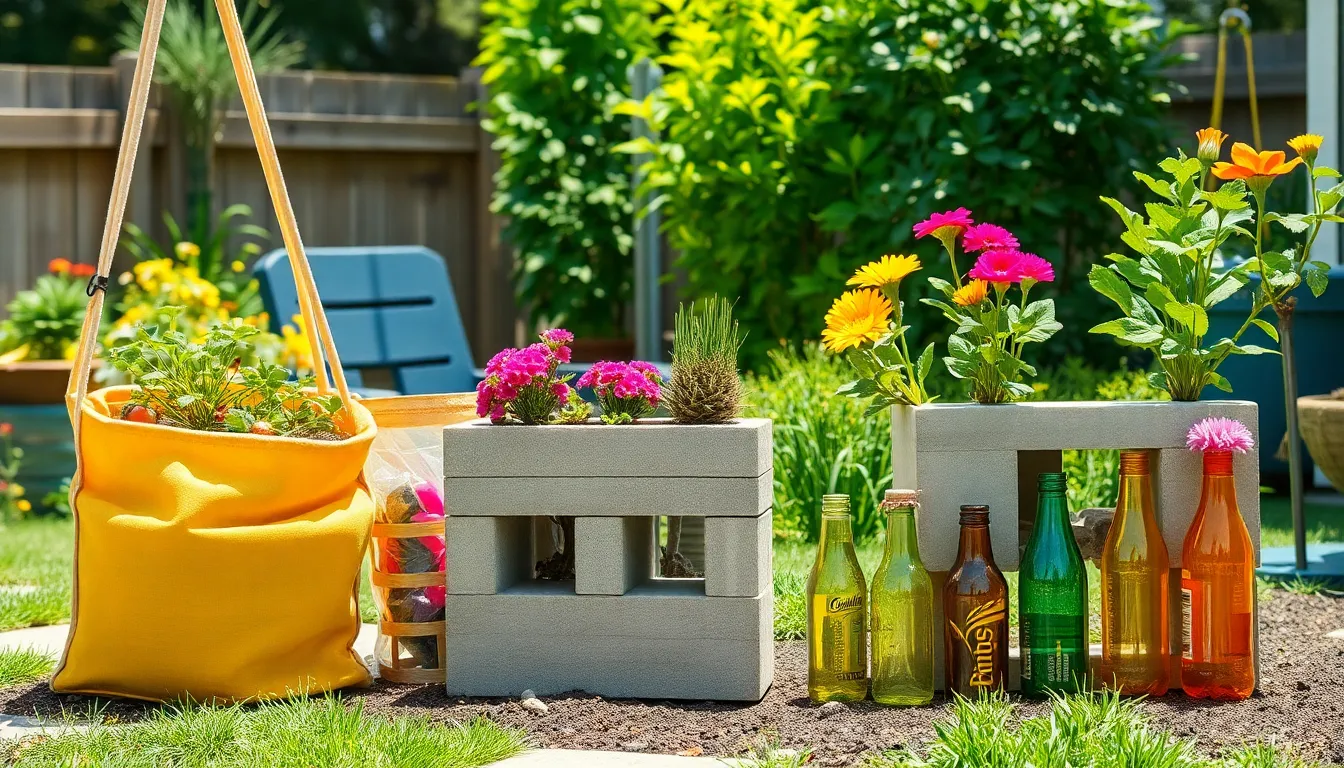
Beyond traditional pottery and wooden planters, we’ve discovered innovative materials that transform ordinary items into extraordinary garden containers. These unconventional options offer unique benefits while adding character to our outdoor spaces.
Fabric Grow Bags for Mobility
Fabric grow bags revolutionize container gardening with their lightweight design and exceptional portability. We can easily relocate these versatile containers throughout our gardens to optimize sun exposure or protect plants from harsh weather conditions. Their breathable material promotes healthy root development by preventing root circling and allowing air pruning, which encourages stronger root systems.
These bags excel in small spaces where traditional containers might feel overwhelming. We’ve found them particularly effective for growing vegetables like tomatoes, peppers, and herbs, as well as annual flowers that benefit from seasonal repositioning. The fabric material naturally regulates soil temperature, keeping roots cooler in summer heat and providing better drainage than rigid containers.
Concrete Blocks for Geometric Designs
Concrete blocks create striking geometric patterns that transform functional gardening into architectural art. We can stack these blocks to form raised planters, create terraced gardens, or arrange them in creative formations that serve as both plant containers and design elements. The hollow centers provide perfect planting spaces for flowers, herbs, and small vegetables.
These blocks offer excellent durability and weather resistance, making them ideal for permanent garden installations. We’ve discovered that different sized blocks allow for varied planting depths, accommodating everything from shallow rooted succulents to deeper rooted perennials. Their neutral gray color provides a modern backdrop that makes colorful plantings pop while maintaining a clean, contemporary aesthetic.
Plastic Bottles for Budget-Friendly Answers
Plastic bottles offer an incredibly cost effective and eco friendly approach to container gardening. We can transform these everyday items into functional mini planters by simply cutting them and adding drainage holes. Two liter bottles work exceptionally well for herbs like basil, cilantro, and parsley, while smaller water bottles suit seedlings and small succulents.
This method allows us to recycle household waste while creating containers that cost virtually nothing. We’ve found that removing labels and painting the bottles can elevate their appearance, creating custom planters that match our garden’s color scheme. The clear plastic also lets us monitor root development and soil moisture levels easily, making them excellent educational tools for teaching children about plant growth.
Vertical Container Garden Ideas for Small Spaces
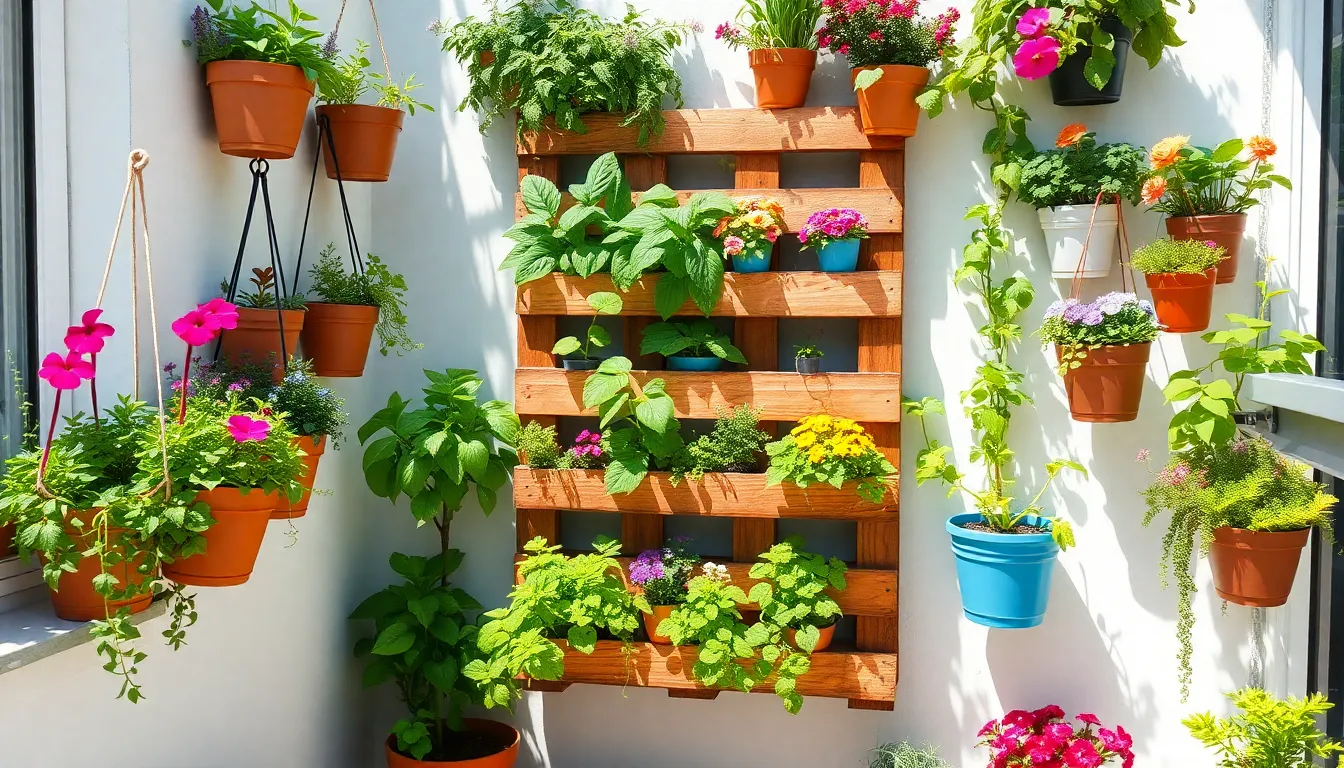
Vertical gardening transforms even the smallest outdoor areas into productive growing spaces by utilizing height rather than width. We’ll explore creative arrangements that maximize your growing potential while adding visual interest to patios, balconies, and compact gardens.
Hanging Basket Arrangements
Layered hanging baskets create stunning visual displays by suspending containers at different heights from sturdy hooks or beams. We recommend using baskets of varying sizes to establish depth and dimension in your vertical garden arrangement. Positioning larger baskets at the bottom and smaller ones at the top creates a natural tiered effect that draws the eye upward.
Themed hanging baskets offer focused growing answers for exact plant types or purposes. We’ve found that herb-themed arrangements work exceptionally well, with baskets dedicated to culinary herbs like basil, oregano, and thyme. Colorful flower arrangements can brighten any space when you combine trailing petunias, cascading lobelia, and vibrant geraniums in coordinated containers.
Strategic placement of hanging baskets ensures optimal growing conditions while maintaining easy access for maintenance. We suggest hanging them at varying heights to prevent overcrowding and allow adequate sunlight penetration to all levels of your garden display.
Tiered Planter Systems
Wooden pallets transform into cost-effective tiered planters when stacked horizontally or vertically against walls or fences. We recommend sanding pallets smooth and treating them with weather-resistant stain to extend their lifespan in outdoor conditions. Stacking pallets horizontally creates stepped planting areas perfect for herbs and small vegetables.
Shelving units maximize vertical space by holding multiple planters at different heights throughout your growing area. We prefer using galvanized steel or weather-resistant wood shelving that can support the weight of soil-filled containers. Custom-built shelving allows you to design exact dimensions that fit your space perfectly.
Multi-tiered container systems stack containers of varying sizes to create tower gardens that make efficient use of limited floor space. We ensure proper drainage by using containers with adequate holes and placing gravel or pottery shards in the bottom of each planter. This method works particularly well for tomato gardens and herb collections.
Wall-Mounted Container Gardens
Wall-mounted planters attach directly to vertical surfaces using sturdy brackets or hooks, freeing up valuable floor space for other uses. We recommend choosing planters with built-in drainage systems to prevent water damage to walls and ensure healthy plant growth. Mounting planters at eye level makes maintenance tasks like watering and harvesting much more convenient.
Living walls create dramatic vertical displays by mounting rows of planters or installing trellis systems along fence lines or building walls. We’ve seen excellent results when combining different sized containers to create visual interest and accommodate plants with varying root systems. This approach improves air circulation around plants while maximizing sun exposure for healthy growth.
Repurposed ladder gardens offer unique vertical growing answers by converting old ladders into plant display structures. We attach hooks, shelves, or window boxes to each rung, creating multiple growing levels in a compact footprint. Lower rungs serve as excellent supports for climbing plants like peas, beans, and cucumber vines.
Seasonal Container Garden Themes and Arrangements
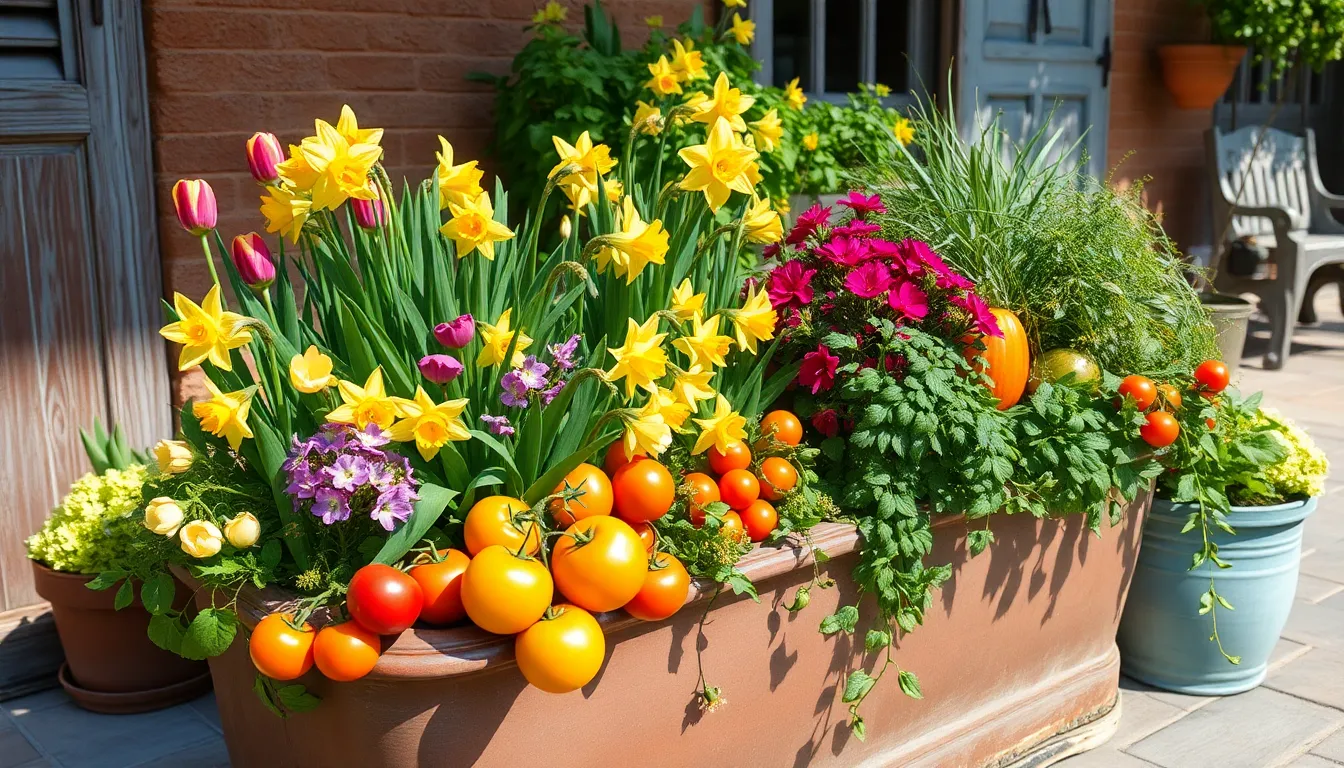
We can transform our container gardens throughout the year by embracing seasonal themes that celebrate each period’s unique beauty. Creating seasonal arrangements allows us to maximize our garden’s visual impact while working with nature’s natural rhythms.
Spring Bulb Container Displays
Container selection plays a crucial role in successful spring bulb displays. We recommend using terracotta or inexpensive nursery pots with proper drainage holes to prevent waterlogged soil. Matching pot sizes to exact bulb types ensures optimal growth: small containers work perfectly for crocus, midsize options suit hyacinths, and large containers accommodate tulips and daffodils.
Layering techniques create stunning sequential blooms through the lasagna planting method. We start by placing the largest bulbs (tulips) at the container’s bottom, followed by midsized varieties (daffodils) in the middle layer, and finish with the smallest bulbs (crocus) positioned near the top. This strategic arrangement provides continuous color from early spring through late season.
Timing considerations become essential for coordinated displays. We plant spring containers in fall, allowing bulbs to experience necessary cold periods before their spectacular emergence. Multiple containers planted at different times can extend the blooming season throughout spring months.
Summer Vegetable Container Gardens
Vegetable selection focuses on varieties that thrive in confined spaces and warm conditions. We choose heat-loving plants like tomatoes, peppers, and herbs that adapt well to container environments and produce abundant harvests. These selections maximize both space efficiency and culinary value in our summer gardens.
Container requirements demand large vessels with excellent drainage systems to support vigorous root development. We use containers measuring at least 18 inches deep and wide for tomatoes, while peppers and herbs can flourish in slightly smaller 12-inch containers.
Arrangement strategies combine complementary vegetables for both aesthetic appeal and practical benefits. We pair tall plants like tomatoes with trailing herbs such as oregano or thyme, creating vertical interest while maximizing growing space. Grouping containers of varying heights adds visual dimension to our summer vegetable displays.
Maintenance scheduling ensures continuous harvests throughout the growing season. We establish regular watering routines during hot summer months and carry out succession planting for herbs and quick-growing vegetables to maintain fresh supplies.
Fall Decorative Container Combinations
Flower combinations showcase autumn’s rich color palette through strategic plant pairings. We combine fall blooming asters and marigolds with colorful foliage plants like ornamental kale and purple cabbage to create vibrant seasonal displays that capture autumn’s essence.
Decorative elements enhance our fall containers with seasonal accessories that complement the plantings. We incorporate small pumpkins, colorful gourds, and preserved fall leaves as natural accents that reinforce the seasonal theme without overwhelming the living plants.
Color coordination emphasizes warm autumn tones through thoughtful plant selection. We choose varieties featuring deep oranges, rich purples, golden yellows, and burgundy reds that harmonize with fall’s natural color scheme. Bronze and copper-toned ornamental grasses add texture and movement to our arrangements.
Extended interest ensures our fall containers remain attractive through early winter months. We select plants with persistent foliage or interesting seed heads that provide continued visual appeal after flowering ends, maximizing our seasonal investment.
Conclusion
We’ve explored countless ways to transform any outdoor space into a thriving garden paradise using creative container answers. From repurposed household items to sophisticated vertical systems these ideas prove that beautiful gardens aren’t limited by traditional boundaries.
The beauty of container gardening lies in its adaptability to your unique style and space constraints. Whether you’re drawn to rustic wooden barrels or sleek metal planters each option offers distinct advantages for different plants and aesthetic preferences.
Start small with what you have available and gradually expand your container collection as your confidence grows. Remember that successful container gardening is about experimenting with combinations that bring you joy while providing optimal growing conditions for your plants.
Your outdoor space is waiting to be transformed into the garden oasis you’ve always envisioned.
Frequently Asked Questions
What is container gardening and who is it suitable for?
Container gardening is a method of growing plants in pots, planters, or other containers instead of directly in the ground. It’s perfect for people with limited outdoor space like apartments, condos, or homes with small patios and balconies. This approach allows anyone to create a thriving garden without extensive land or ideal soil conditions.
What are some creative alternatives to traditional terracotta pots?
You can repurpose many household items as unique planters, including old boots and shoes, vintage bathtubs, kitchen colanders, wine barrels, wooden pallets, galvanized steel tubs, vintage metal buckets, and even tin cans. These alternatives add personality to your garden while being cost-effective and environmentally friendly.
What materials work best for container gardening?
Popular materials include cedar wood (naturally rot-resistant), metal options like corten steel and galvanized steel, ceramic and terra cotta pots (promote healthy root growth), fabric grow bags, and concrete blocks. Each material offers different benefits in terms of durability, aesthetics, and plant health.
How can I maximize space in a small container garden?
Utilize vertical gardening techniques such as hanging baskets, tiered planter systems, wall-mounted containers, and repurposed ladder gardens. These methods help you grow more plants by using height rather than floor space, making them ideal for balconies and small patios.
Can I create seasonal themes with container gardens?
Yes! Container gardens are perfect for seasonal displays. Create spring bulb arrangements with layered planting techniques, summer vegetable gardens with heat-loving plants, and fall decorative combinations using colorful foliage and seasonal elements. This flexibility allows you to refresh your garden’s appearance throughout the year.
What should I consider for proper drainage in containers?
Ensure all containers have adequate drainage holes to prevent waterlogging. Kitchen colanders naturally provide excellent drainage for herbs, while repurposed items may need holes drilled. Proper drainage is essential for healthy root development and preventing plant diseases caused by excess moisture.

